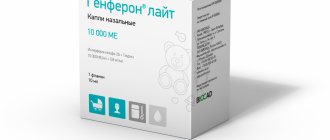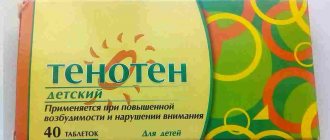Composition per 1 ml
Active substance: xylometazoline hydrochloride – 0.50 mg or 1.00 mg; Excipients: disodium edetate (Trilon B) – 0.50 mg, sodium chloride – 9.00 mg, benzalkonium chloride – 0.15 mg, potassium dihydrogen phosphate – 3.63 mg, sodium hydrogen phosphate dodecahydrate – 7.13 mg, purified water – up to 1 ml.
Description: transparent, colorless or slightly colored liquid.
Pharmacotherapeutic group: anticongestive agent – alpha-adrenergic agonist.
ATX code : R01AA07
How to use Rinostop for children
The drug in a reduced dosage of 0.05% is approved for treatment from 2 years of age. For children under 6 years old, it is enough to apply the spray or instill the product 2-3 times a day, 1 drop or one press of the dispenser into each nostril, after blowing their nose and clearing the nose of mucus.
It is more optimal to use a spray, since it does not require tilting your head during application, evenly irrigates the mucous membranes, and creates a lower risk of overdose.
The drug at a concentration of 0.1% can be used from 6 years of age:
- 6–10 year old children: no more than 2 times a day, 1 drop or spray into both nostrils;
- from 10 years: up to 3 times a day, 1-2 doses in each nostril.
One-time or 2-3-day use of a vasoconstrictor is preferable.
Contraindications
Hypersensitivity to xylometazoline and other components of the drug, arterial hypertension, tachycardia, severe atherosclerosis, glaucoma, atrophic rhinitis, surgical interventions on the meninges (in history), conditions after transsphenoidal hypophysectomy, children's age (up to 2 years - for 0.05% spray , up to 6 years for 0.1% spray), pregnancy. Do not use during therapy with monoamine oxidase inhibitors and tricyclic antidepressants (including the period of 14 days after their discontinuation).
When is Rinostop contraindicated?
It is necessary to refuse the use of the drug:
- for chronic glaucoma;
- with atrophy of the nasal mucosa;
- for hypertension and hypertension;
- for heart rhythm disturbances: bradycardia, tachycardia;
- individual hypersensitivity to the components of the drug;
- after brain surgery;
- cerebrovascular accidents;
- during treatment with tricyclic antidepressants, MAO inhibitors.
Rinostop requires careful use in diabetes mellitus, thyroid diseases, high cholesterol levels, atherosclerotic changes in blood vessels, and prostate hyperplasia.
Directions for use and doses
Intranasally.
Spraying is carried out after removing the safety cap from the sprayer. The sprayer is inserted into the nose and, pressing on its base, sprays for 1 second.
For adults and children over 6 years of age (0.1% spray): one spray from a spray bottle into each nasal passage, usually 3-4 sprays per day are sufficient; should not be used more than 3 times a day.
For children aged 2 to 6 years (0.05% spray) one spray from a spray bottle into each nasal passage 1 or 2 times a day; should not be used more than 3 times a day.
Do not use the drug without a break for more than 3-5 days.
What does Rinostop help with?
Xylometazoline, getting on the mucous membrane, narrows capillary vessels, stimulates the outflow of fluid, eliminates swelling, freeing the nasal passages and relieving congestion. This is a symptomatic drug, its compounds act locally, a small amount of the drug is absorbed into the bloodstream, which is unable to cause systemic effects for the body.
The mechanism of operation of Rinostop is based on the reaction of adrenoline receptors. The narrowing of the nasal capillaries and the reduction of swelling as a result of its use helps prevent further complicated course of the respiratory disease, prevent inflammation of the middle ear or the development of acute sinusitis.
The effect occurs 2–4 minutes after applying the solution to the mucous membranes and lasts up to 6–8 hours.
Correct use of the medicine does not lead to disruption of the functions of the ciliated epithelium and the synthesis of protective mucous secretion. The drug does not affect the general course of the disease and infectious pathogens. It reduces symptoms and restores physical comfort by restoring nasal breathing.
Side effect
With frequent and/or prolonged use - irritation and/or dryness of the nasopharyngeal mucosa, burning and paresthesia of the nasal mucosa, sneezing, hypersecretion of the nasal mucosa; swelling of the nasal mucosa, vomiting, headache, palpitations, increased blood pressure, tachycardia, arrhythmia, insomnia, blurred vision, depression (with long-term use of high doses).
Benzalkonium chloride, which is part of the drug, can cause irritation of the nasal mucosa.
When should you use Rinostop?
Indications for using the nasal solution include:
- acute rhinitis with nasal congestion;
- vasomotor, allergic and other types of runny nose, accompanied by swelling of the mucous membranes and impaired nasal breathing;
- for sinusitis, sinusitis and other sinusitis with congestion and swelling of the nasal sinuses;
- with inflammation and swelling of the auditory tube;
- in preparation for diagnostic procedures before treatment with an otolaryngologist.
Rinostop is not a long-acting drug. It must be used once or in short courses over several days. Otherwise, the risk of side effects and complications increases.
Overdose
In case of an overdose or accidental ingestion of the drug, the following symptoms may develop: nausea, vomiting, cyanosis, fever, tachycardia, arrhythmia, increased blood pressure, shortness of breath, mental disorders, depression of the central nervous system (drowsiness, decreased body temperature, bradycardia, decreased blood pressure, respiratory arrest and coma).
Treatment: symptomatic: in case of accidental ingestion - gastric lavage, taking activated charcoal.
Rinostop nasal drops 0.1% 10ml fl-drops PE
Registration Certificate Holder
PHARMSTANDARD-LEKSREDSTVA (Russia)
Dosage form
Medicine - Rinostop (Rhinostop)
Description
Nasal drops 0.1%
transparent, colorless or slightly colored.
1 ml
xylometazoline hydrochloride 1 mg
10 ml - bottles with a dropper cap (1) - cardboard packs.
Indications
To reduce swelling of the mucous membrane of the nasopharynx and discharge in acute allergic rhinitis, acute respiratory infections with symptoms of rhinitis, sinusitis, hay fever, otitis media; preparing the patient for diagnostic procedures in the nasal passages.
Contraindications for use
Hypersensitivity to xylometazoline; atrophic rhinitis, thyrotoxicosis; inflammatory diseases of the skin or mucous membrane of the nasal vestibule; condition after transsphenoidal hypophysectomy; patients with severe cardiovascular diseases (for example, coronary artery disease, angina pectoris, tachycardia, arterial hypertension, severe atherosclerosis); patients with a history of surgical interventions on the meninges; patients receiving MAOI or other drugs that can cause an increase in blood pressure; patients with increased intraocular pressure, especially with angle-closure glaucoma; during therapy with tricyclic and tetracyclic antidepressants, other local vasoconstrictors (decongestants); pregnancy; children's age - depending on the dosage form.
Carefully:
patients with hypersensitivity to adrenomimetics, accompanied by symptoms of insomnia, dizziness, arrhythmia, tremor, increased blood pressure; patients with pheochromocytoma, porphyria; patients with endocrine diseases (for example, hyperthyroidism, diabetes mellitus); patients with prostatic hyperplasia; during lactation (breastfeeding).
pharmachologic effect
Vasoconstrictor for local use in ENT practice. Alpha adrenergic agonist. When applied to the mucous membranes, it causes a narrowing of the blood vessels of the nasal mucosa, thus eliminating swelling and hyperemia of the nasal mucosa, and restores the patency of the nasal passages. For rhinitis, it facilitates nasal breathing.
Drug interactions
It is possible to enhance the systemic effect of xylometazoline with simultaneous use of MAO inhibitors and tricyclic antidepressants. The simultaneous use of xylometazoline with tetracyclic antidepressants, other local vasoconstrictors (decongestants), as well as other drugs that increase blood pressure is incompatible.
Dosage regimen
Use intranasally. The dose depends on the dosage form used and the age of the patient.
Side effect
From the immune system:
uncommon - hypersensitivity reactions (angioedema, skin rashes, itching).
From the digestive system:
rarely - nausea, vomiting.
From the nervous system: rarely - headache; very rarely - insomnia, anxiety, fatigue, hallucinations and convulsions (mainly in children).
From the side of the organ of vision:
very rarely - blurred vision.
From the cardiovascular system:
rarely - palpitations, increased blood pressure, tachycardia; very rarely - arrhythmia.
Local reactions:
often - irritation and/or dryness of the nasopharyngeal mucosa, burning and paresthesia of the nasal mucosa, sneezing, hypersecretion of the nasal mucosa; infrequently - swelling of the nasal mucosa, nosebleeds, withdrawal syndrome. Possible increased swelling of the nasal mucosa (reactive hyperemia).
special instructions
Long-term use (more than 7 days) and overdose of sympathomimetics that have a decongestive effect can lead to reactive hyperemia of the nasal mucosa. As a result, difficulty in nasal breathing occurs, which leads to the patient starting to use xiometazoline repeatedly or even constantly. This can lead to chronic swelling (medicinal rhinitis), and eventually even to atrophy of the nasal mucosa (ozena).
In milder cases, to improve the patient's condition, you can first stop injecting the sympathomimetic into one nostril, and after the complaints have subsided, continue to inject it into the other nostril to at least partially ensure nasal breathing.
Recommended doses should not be exceeded, especially in children and elderly patients.
Effect on the ability to drive vehicles and operate machinery.
With long-term treatment or when using xylometazoline in higher doses, the possibility of its systemic effect cannot be excluded. If systemic side effects develop, it is necessary to refrain from driving vehicles and engaging in other potentially hazardous activities that require increased concentration and speed of psychomotor reactions.
Use during pregnancy and breastfeeding
Restrictions during pregnancy - Contraindicated. Restrictions when breastfeeding - With caution. Contraindicated for use during pregnancy. During lactation, use is possible only as prescribed by a doctor, after a careful assessment of the ratio of the expected benefit for the mother to the potential risk for the child. Exceeding recommended doses is not allowed.
Use in elderly patients
Restrictions for elderly patients - Use with caution.
Do not exceed recommended doses in elderly patients.
Use in children
Restrictions for children - With caution.
It can be used in children according to indications, in doses and dosage forms recommended according to age. It is necessary to strictly follow the instructions in the instructions for xylometazoline preparations regarding contraindications for the use of specific dosage forms of xylometazoline in children of different ages. Do not exceed recommended doses in children.



